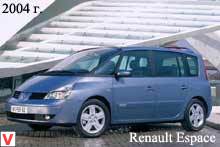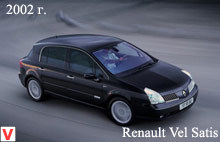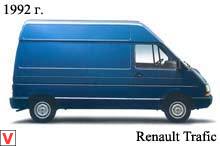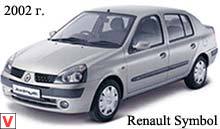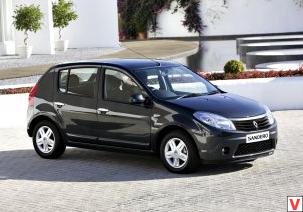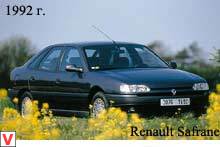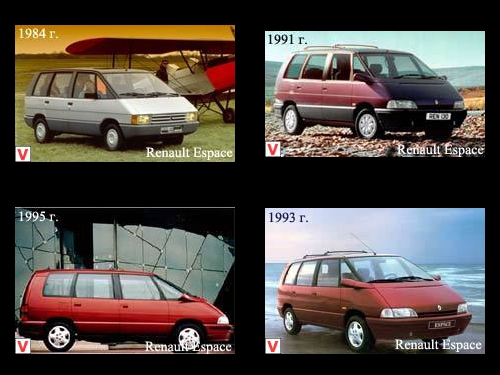
The Espace mini-van debuted at the end of 1984. Renault has presented to the general public a single-volume multi-seat car with a plastic body. The design of Espace was developed by the aerospace company Matra, which started the production of this unusual car in its factory, but under the Renault brand. By the way, in translation from French the sonorous name Espace means "space". For that time, Espace is the embodiment of the most daring and creative ideas. Unusual for the mid-1980s, the body with the windshield, forming one line with the hood, allowed for excellent aerodynamic performance (Cx 0.32).
The ability to transform the cabin, thanks to the rearranged arbitrarily seats of the middle and rear rows, allows you to comfortably accommodate up to seven passengers. Renault Espace - successfully combines the volume of a small van and the comfort of a middle-class passenger car. Overall dimensions are 4365x1777x1660 mm.

The luggage compartment volume is 250 liters. The car is not subject to corrosion, because the power frame of the body is galvanized, and all its outer panels are made of plastic of a special grade and are attached to the frame with rivets and glue. The first generation was introduced with the Espace GTS, TSE and Espace Turbo D, Turbo DX versions. The first version of Espace received a 2-liter engine with 110 hp, a diesel version with a 88-horsepower unit appeared a little later. In the fall of 1986, the range of power units was supplemented with injection engines of 2.0 and 2.2 liters capacity of 120 and 110 hp. respectively.
Thanks to the versatility of its design, Espace was in quite high demand. In France, it was often used as a car of special services, “ambulance”, not to mention the use as a radio taxi, office minibus or delivery van. In early 1988, the all-wheel drive version of the Quadra appears. In 1989, the Espace family underwent an easy modernization. Remade grille, headlight, "turn signals" and the shape of the bumpers. From the trim dashboard removed fabric insert. In 1991 there was a restyling, and the second generation Espace mini-vans appeared. The design of the car dramatically changed.
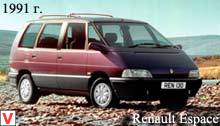
The front and rear parts with narrow and rounded block headlights and lanterns, smoothed contours of the bonnet and front fenders, integral side mirrors in shape, made the exterior of the Espace unrecognizable. A different outline has acquired the instrument panel. It became rounded, but retained a characteristic front shelf extending to a large windshield carried forward. The spacious interior offers three rows of seats and a variety of transformation options.
The seventh and eighth seats were installed only for an additional fee, airbags were not included in the standard package since 1995, until then only standard seat belt anchors, side protection beams mounted in the doors, and head restraints on all seats were installed. In the basic configuration, the 1991 model was equipped with a triple sliding panel in the roof and a 100-watt Hi-Fi stereo system. Renault Espace II minivan is highly appreciated for the comfort, visibility and dynamism of powerful engines, the number of which is four for this version, including the 153-horsepower 2.85-liter V6 engine with automatic transmission from the Renault 25 model.

In 1996, the third generation Renault Espace with transverse engines came off the assembly line. The updated version has a digital display on the dashboard. Standard equipment includes airbags for the driver and front passenger, front belts with pretensioners and force limiters on the belts of all other seats (middle seat belt of the second row - two-point). The range of engines was: injection 2.0 l / 114 hp, 3 l V6 / 167 hp, as well as a 2.2-liter 12-valve turbo diesel (G8TT) with 113 hp, with which the flow fuel does not exceed 10.6 l / 100 km.
In 1998, the range of engines was upgraded. A 16-valve version of the 2.0-liter engine produces 140 hp. Modern design and an even more comfortable and functional interior extended the stay of this car at the peak of popularity, until in 2002 the next model change took place. The last generation appeared in 2002. Instead of a composite body, steel appeared. The car assembles a plant in Sanduville in France. Espace VI is a fundamentally new design.

The design is made in the style of the latest innovations of the company, which is combined with a number of traditional Espace moves. In particular, the acute-angled bi-xenon headlamps here are side by side with triangular side windows in front of the front doors, new Espace reverse rear pillars with vertical rear lights mounted in them - with the traditional Renault five-door body with hinged doors. In addition, such “family” features can be noted, such as a trapezoid membrane with a “slogan” in the middle, dividing the radiator grill into two parts, triangular repeaters of the direction indicators in the front fenders, round wheel arches.
Like its predecessor, Espace IV is offered with two variants of the base - standard and extended. Passenger seats in the Espace interchangeable: they can be removed - all or as needed. The massive steering wheel is trimmed in leather and is adjustable in height and reach. Information about the speed, the distance traveled and the state of the engine, as well as the operation of the suspension, the ABS, ESP systems and cruise control is displayed on a multi-color LCD display of an electronic instrument panel located in the slot in the center of the dashboard. In the traditional sense, there is no central console, the gear lever is located on the floor.

The parking brake lever is not at all, it is automatic. And, of course, here is the traditional key card for the new Renault instead of the usual ignition keys. And traditionally high for the new Renault security level. Espace has the highest score - five stars out of five - according to the results of crash tests EuroNCAP.
Espace IV has a solid internal space. The car can comfortably carry up to seven people: two in the front, three in the second row of seats and two more in the third. In this case, the central second-row seat can be simply removed by making free access to the rear-row seats. Visibility impairments due to the use of wider racks than the third generation did not happen: a rational angle of inclination and a good profile "take away" the racks from the most intense part of the visual field. The new Espace has a whole gamut of the most modern engines, including the latest 175 hp aluminum turbodiesel V6 from Isuzu. Total line of power units has six engines - three petrol and three diesel.
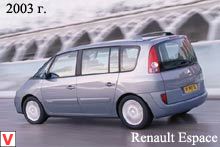
For twenty years, Espace has successfully conquered the world and in the fourth generation reached a significant number - a million.
Other images auto Renault Espace
